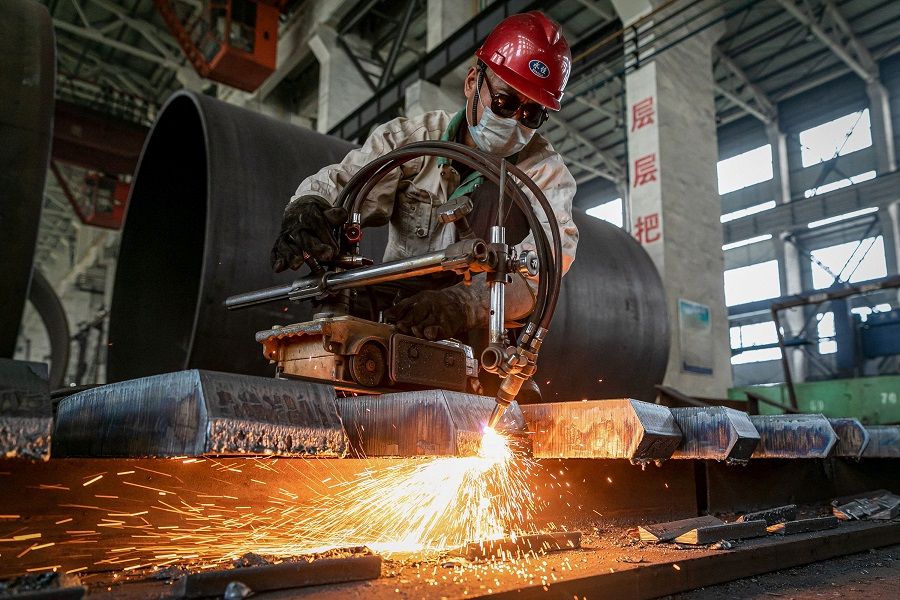Dual circulation strategy revisited: China deepens integration with the global economy

Following the onset of the Covid-19 pandemic, Chinese leaders proposed a new "dual circulation" development strategy with its domestic market as the mainstay, and with domestic and international circulations complementing each other. Thereafter, some observers opined that China was changing its opening-up policies that have been in place for some 40 years, and that it was turning to domestic supply and demand to drive economic growth. This marked a transition from an open economy to a self-reliant one.
China's economy still dependent on external trade
However, as of now, other than a drastic reduction in business travel due to the pandemic, China has not significantly reduced its economic exchanges with the rest of the world in any other way. On the contrary, the Chinese economy has become more connected and integrated with the global economy.
While the dual circulation strategy evokes images of rising domestic demand and falling foreign trade, the reality is that China's total import and export rose in spite of the pandemic and its trade war with the US. Foreign trade in goods is one of three engines that drive China's economic growth. In 2020, the country's foreign trade in goods was a staggering 32 trillion RMB (approximately S$6.6269 trillion), accounting for more than 30% of its GDP, which is higher than that in open economies such as the US and Japan when similar indicators are compared.
Guided by its dual circulation strategy, between January and May this year, China's total foreign trade continued to grow rapidly by 38%, with total exports rising by 40% and total imports increasing by 36%. Such figures are seldom seen anywhere, even before the pandemic. They indicate that external demand and supply are still very important drivers of Chinese economic development.
Impacted by the pandemic, global aggregate foreign direct investment (FDI) shrank considerably in 2020, but FDI in China bucked the trend to grow to US$202.1billion, making it the top recipient of FDI worldwide.

Amongst China's major trading partners, ASEAN continues to rank as the largest, reflecting the deep integration of the Chinese economy with the Southeast Asian economy. Despite political disputes, bilateral trade between China and the EU, and between China and the US also saw impressive growth of 28.7% and 41% respectively. The growth in Sino-US trade is all the more remarkable given that the US continues to impose Trump-era punitive tariffs on Chinese goods. Since the beginning of this year, China's economic and trade ties with the major global economies have grown significantly.
Increase in investments in China and abroad
Impacted by the pandemic, global aggregate foreign direct investment (FDI) shrank considerably in 2020, but FDI in China bucked the trend to grow to US$202.1billion, making it the top recipient of FDI worldwide. This can be attributed to the Chinese government lifting some of the restrictions it imposed on foreign investment in China and opening up more sectors to foreign companies.
China's approach of using a negative list to manage foreign investment has simplified the approval procedure for such investments. The country's Foreign Investment Law which came into effect last year provides legal protection for the legal rights of foreign investors. At the same time, China's service sector is also opening up in an orderly manner.
After the trade war broke out between the US and China, some people felt that global supply chains would become less reliant on China. In fact, only some manufacturing plants moved out of China, which is actually aligned with the country's aim to move up the value chain. As China continues to open up new sectors to foreign investment and develops its economy, more foreign companies will invest in higher value-add industrial activities in the country. In the first four months of this year, China's actual usage of foreign investment grew more than 30%, with the service sector accounting for 78.8% of this rise.
Presently, it is moving faster to invest in the manufacturing sector of some developing countries. Rather than a passive receiver, China is actively involved in reshaping the global supply chain.

At the same time that China is attracting investment, it is also investing overseas. Even though this has been greatly affected by the pandemic, it is still growing, with investments in Belt and Road Initiative (BRI) countries rising at a quicker pace of 14% between January and April this year. At the same time, China is also one of the drivers of global supply chain diversification. Presently, it is moving faster to invest in the manufacturing sector of some developing countries. Rather than a passive receiver, China is actively involved in reshaping the global supply chain.
Contrary to what some people think, China's dual circulation strategy does not signal that it is turning inwards. Instead, it aims to highlight its earlier weak points of weak domestic demand and R&D, and allows China to adapt to the altered global landscape. China's trade war with the US has shown Chinese leaders how vulnerable China can be due to an over reliance on external technologies and markets. This coupled with the country's growing economy has made the Chinese government see the importance of the domestic market.
In developed economies around the world, domestic consumption accounts for a much greater proportion of GDP than in China. This means that in the long term, as China gradually becomes a high-income nation, the main driver of its economy would be domestic demand, and this is one of the main reasons why its domestic market is the mainstay of the dual circulation strategy. This certainly does not equate to China abandoning its opening-up policies.
In addition, the strategy also emphasises domestic and international circulations complementing each other, meaning that foreign economic activities will continue to play very important roles for China. At the same time, the further opening up of China will ensure that its domestic economic activities continue on desirable paths of development, while the deepening of domestic reforms will in turn promote further opening up. China's opening up is a long-term national strategy rather than a temporary fix.
